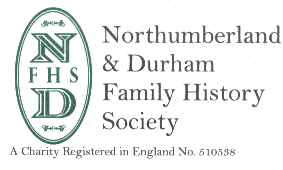 Reports
Reports

|
South Tyneside Meeting - September 2002"Gravestones I Have Known" by Geoff NicholsonA Report by Margaret Stafford |
This month's topic was "Gravestones I have known", and the speaker, Mr Geoff Nicholson, began by explaining that he had been engaged at only 48 hours notice, so he would be giving us a few general remarks, followed by a collection of anecdotes about the recording of Monumental Inscriptions.
In his opening remarks, Geoff referred to the very large amount of work which has been done locally, both by the NDFHS and by commercial companies, but nevertheless he thought that a great deal still remained to be done.
Although most of the old churchyards in the NE, including all of those in S Tyneside, have been recorded and published, municipal cemeteries, dating from the mid-nineteenth century onwards, have still not all been covered. South Tyneside has a better-than average coverage, with Westoe Cemetery and Jarrow Cemetery both being published on NDFHS microfiche, thanks to John and Jenny Ashburner and their helpers, and the other major cemetery of South Shields, the huge Harton one, not to be confused with Harton St Peter's churchyard, visible from the window of our meeting-room, being now well under way and partly published, by a commercial company, Lindenbridge Publications.
Cemeteries at Hebburn and at Boldon have not yet been touched, however, so there is plenty of scope for anyone wishing to get involved with the work for the NDFHS.
The other work still needing to be done was in the old churchyards, some of which were recorded in the 1970s, at a time when a wave of "clearance schemes" meant that gravestones were being removed and destroyed at a very great rate, and MI recording was something of a "rescue operation". It was then decided that since all those who lived after 1851 were recorded on the censuses every ten years for the rest of their lives, their MIs were not quite as important as those of people who died before 1851. Accordingly, in many cases only stones dating from before 1851 were recorded, others being dismissed as "modern". That way each churchyard could be recorded in a shorter time.
While most of the South Shields churchyards have been fully recorded, there are still a few on the fringes which are consequently only done to 1851. Very little coverage has been completed in Sunderland for example. What would have once been major sources, the churchyards of Sunderland Holy Trinity and of Monkwearmouth St Peter's, were both effectively cleared many years ago, and only the few stones now remaining out of the original hundreds have been recorded.
Another commercial publisher (Original Indexes) has now recorded and published the churchyard of Bishopwearmouth St Michael's ("Sunderland Minster" to give it its modern name) but the three vast main cemeteries of the city of Sunderland have not yet been touched - and within them more stones are being lost to vandalism and decay every week. They are Bishopwearmouth Cemetery (Chester Road), Sunderland Cemetery (Ryhope Road) and Mere Knolls Cemetery (Seaburn).
Geoff commented that if the south Tyneside group was looking for a project then Mere Knolls, being closest to S Tyneside, is perhaps the one to consider once Hebburn and Boldon Cemeteries have been done. He also mentioned that within the "wider Sunderland", ie those places added to Sunderland in 1974, he had recorded to 1851 the churchyards of Usworth, Washington, and Penshaw, both of which need to be up-dated. He would have added Boldon to that list if it were not that the indomitable Ashburners had made a complete recording of that churchyard.
In the second part of his talk, Geoff gave us some anecdotes about particular stones he had come across, including an eighteenth century miner's memorial at Ryton, which he was surprised was not better known, and a most unusual stone from the same churchyard, the only one he knows of which has, at the bottom, a "PS". (note to you all - I will ask Geoff what the PS says - I'm intrigued myself!)
He also mentioned some of the physical hazards he had come across, ranging from red ants at Byrness (warning - never sit down on any small mound of earth, no matter how conveniently placed it may be!) to an electric fence to control sheep at Embleton, stumbling backwards into which produced a most amazing sensation!
He ended by quoting some amusing epitaphs, published in Michael Southwick's Book "Ancestral Anomalies", the most succinct, supposed to have come from Minnesota, USA, being "Once I wasn't, Then I was, Now I ain't again".